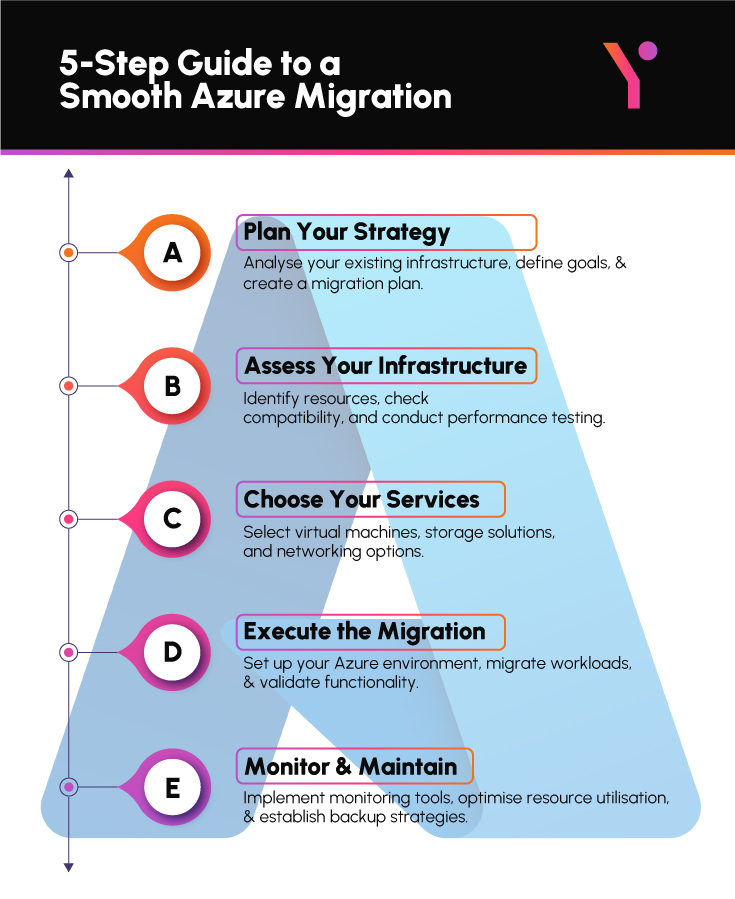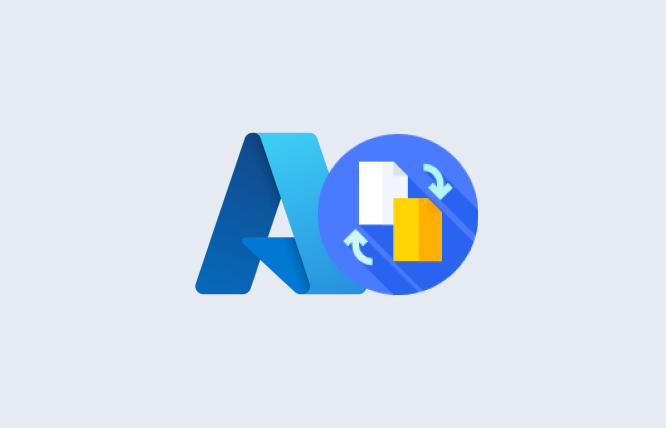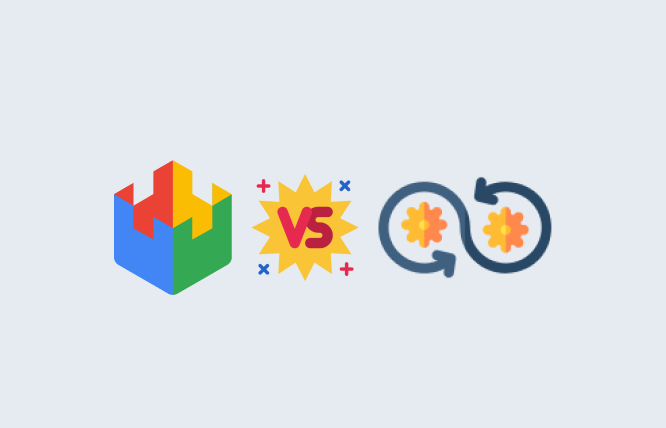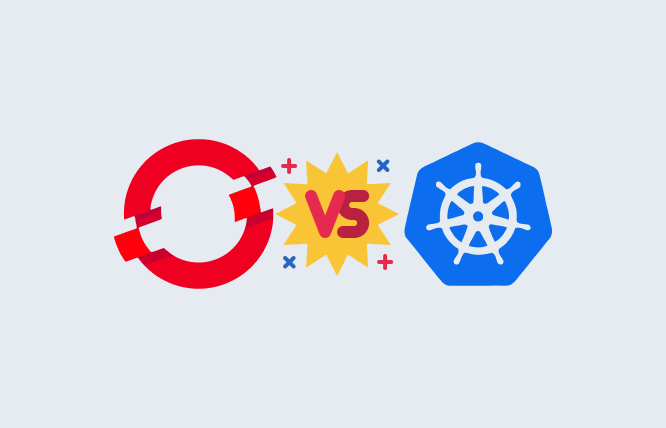Introduction
This blog offers a comprehensive guide to navigating the Azure migration process, providing Azure migration step by step strategies and essential recommendations for a successful transition to Microsoft’s cloud platform.
If you’re contemplating migrating your infrastructure to Azure, this will be your blog for all things related to Azure migration steps.
As we know, the transition to cloud computing has become imperative for businesses seeking scalability, flexibility, and cost-effectiveness. Among the top contenders in this arena is Microsoft Azure, renowned for its brand value and range of services for all kinds of business needs.
Before delving into the intricacies of Azure migration strategies, conducting a thorough assessment of your existing infrastructure is paramount. This step provides insights into your current environment, dependencies, and potential obstacles to ensure an effortless transition. So, without further ado, let’s dive straight into Azure migration step by step process.
What is Azure Migration Service?
Azure Migration Service is a suite of tools and resources provided by Microsoft to facilitate the migration of workloads, applications, and data to the Azure cloud platform. These services are designed to simplify the migration process, minimise downtime, and ensure a smooth transition to the cloud.
Azure Migration offers various tools and methodologies to facilitate different types of migrations and cloud development services, including.
Azure Migrate
Azure Migrate helps with moving your stuff from your own computers to Azure. It checks what you have and figures out the best way to migrate it.
Azure Site Recovery
This will copy your data from your own computers to Azure, so if something breaks, you can keep working.
Azure Database Migration Service
Database migration makes it easy to migrate your databases to Azure. It works with different kinds of databases and helps you migrate without disrupting your business.
Azure Data Box
Data Box is like a big USB stick that you can send to Azure. It helps migrate lots of data quickly, even if your internet is slow.
Azure Data Migration Assistant
This migration assistant checks if your databases can work in Azure. It helps you fix problems and migrate your databases without stopping them.
What are the benefits of Cloud Migration?
Before diving into the specifics of Azure migration steps, let’s first explore the benefits of migrating to the cloud:
Scalability:
Azure helps you scale your resources based on your demand for performance and cost efficiency.
Flexibility:
With Azure’s extensive range of services, like serverless web development on Azure, you can pick the tools and tech stacks that best fit your requirements.
Cost Savings:
By migrating to Azure, you may minimise infrastructure costs and hardware maintenance costsand pay only for the resources you use.
Improved Security:
Azure provides the highest standards of security features and compliance certifications to protect your data and applications from threats and vulnerabilities.
Global Reach:
With data centres located around the world, Azure enables you to reach customers and users globally with low-latency connections.
Azure Migration Steps (5-Step Process)
Let’s go through the Azure Migration step by step process from start to end:

STEP 1: Planning Your Azure Migration Strategy
The first step in migrating to Azure is to develop a comprehensive migration strategy tailored to your business goals and requirements.
Start by conducting an in-depth analysis of your existing infrastructure, apps, and data to find connections, performance metrics, and problems with compatibility.
Clearly define your migration goals. They could be saving money, improving performance, or enhancing scalability. Then, focus on migrating the important things first.
Then, develop a migration plan outlining the sequence of migration activities, timelines, resources, and potential risks and mitigation strategies.
STEP 2: Assessing Your On-Premises Infrastructure
Once you have a clear migration strategy in place, now assess your on-premises infrastructure to determine its readiness for migration.
Catalogue all your on-premises servers, applications, and databases, including their configurations, dependencies, and resource utilisation.
Evaluate the compatibility of your workloads with Azure services and identify any dependencies or constraints that may impact the migration process.
Lastly, conduct performance testing to assess the performance impact of migrating your workloads to Azure and optimise resource allocation accordingly.
STEP 3: Selecting the Right Azure Services
With a clear understanding of your Azure migration strategies and the readiness of your on-premises infrastructure, the next step is to select the right Azure services to support your workloads.
Select the appropriate computing services that your project requires, such as virtual machines, containers, serverless web development, or serverless computing.
Determine the most suitable storage solutions, such as Azure Blob Storage, Azure Files, or Azure Disk Storage, based on your data storage and access needs.
Now configure networking options, such as virtual networks, load balancers, and VPN gateways, to ensure secure and prompt communication between your Azure resources.
STEP 4: Executing the Migration Process
With your migration strategy in place and the right Azure services selected, it’s time to execute the migration process.
Set up your Azure environment, including creating Azure subscriptions, resource groups, and networking configurations to support your migration workloads.
Utilise necessary Azure Migration Service tools, such as Azure Migrate, Azure Site Recovery, or Azure Database Migration Service, to migrate your workloads, applications, or data to Azure.
Eventually, validate the success of your migration by testing your applications and workloads in the Azure development environment.
STEP 5: Continuous Monitoring and Maintenance in Azure
Once your migration is complete, the final step is to keep an eye on continuous monitoring and maintenance of your Azure environment.
Implement monitoring and logging solutions, such as Azure Monitor and Azure Security Center, to monitor the performance, security, and compliance of your Azure resources.
Thoroughly monitor and optimise your Azure resources to ensure optimal performance, cost efficiency, and scalability. Last but not least, establish disaster recovery plans and backup strategies to protect your data and applications from unforeseen outages or disasters.
Expert Tips and Recommendations for Azure Migration Step by Step
- Create clear Azure migration strategies that fit your business goals, deciding what to migrate first and setting goals.
- Assess what you have carefully before migrating anything, and make a detailed plan with what you need and when to do it.
- Get everyone involved from the start, including bosses, IT teams, and people who will use the new system.
- Use tools like Azure Migrate and Azure Site Recovery to make migrating data easier.
- Keep your data safe while migrating by making sure every aspect is secure and follows the guidelines.
- Plan for processes to keep working even if something goes wrong, like having backups and plans for emergencies.
- Keep improving even after you’ve migrated everything, and experiment with changes by using tools to make things easier.
- Ask for help from experts if you need it, like a professional who knows about Azure and can help with problems.
Frequently Asked Questions
You can seek expert guidance from our Azure-certified professionals and consulting partners at FuturByte. They can help you navigate complex migration challenges and maximise the value of Azure for your business.
Migrating to Azure offers benefits like scalability, flexibility, and cost savings. It allows you to access multiple services and resources to support your business needs.
While Azure migration steps can be complex, careful planning and execution can simplify the process. Using tools and resources provided by Azure can streamline migration tasks and reduce complexity.
Doing a thorough assessment of your existing infrastructure is the first and foremost task to do. Look for dependencies, performance metrics, and compatibility issues to determine if migration is feasible.
While AWS consulting companies primarily specialise in Amazon Web Services (AWS), some may offer expertise in Azure migration as well. However, FuturByte offers full-scale cloud development and migration services; consult our experts to get customised Azure migration strategies.
Azure consulting companies specialise in assisting businesses with Microsoft Azure services, while AWS consulting companies focus on Amazon Web Services. Each offers expertise tailored to their respective cloud platforms, catering to their clients’ unique needs and requirements.
Have questions or feedback?
Get in touch with us and we‘l get back to you and help as soon as we can!




